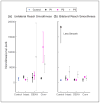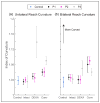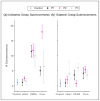Movement quality of conventional prostheses and the DEKA Arm during everyday tasks
- PMID: 26932980
- PMCID: PMC5511738
- DOI: 10.1177/0309364616631348
Movement quality of conventional prostheses and the DEKA Arm during everyday tasks
Abstract
Background: Conventional prosthetic devices fail to restore the function and characteristic movement quality of the upper limb. The DEKA Arm is a new, advanced prosthesis featuring a compound, powered wrist and multiple grip configurations.
Objectives: The purpose of this study was to determine if the DEKA Arm improved the movement quality of upper limb prosthesis users compared to conventional prostheses.
Study design: Case series.
Methods: Three people with transradial amputation completed tasks of daily life with their conventional prosthesis and with the DEKA Arm. A total of 10 healthy controls completed the same tasks. The trajectory of the wrist joint center was analyzed to determine how different prostheses affected movement duration, speed, smoothness, and curvature compared to patients' own intact limbs and controls.
Results: Movement quality decreased with the DEKA Arm for two participants, and increased for the third. Prosthesis users made slower, less smooth, more curved movements with the prosthetic limb compared to the intact limb and controls, particularly when grasping and manipulating objects.
Conclusion: The effects of one month of training with the DEKA Arm on movement quality varied with participants' skill and experience with conventional prostheses. Future studies should examine changes in movement quality after long-term use of advanced prostheses. Clinical relevance Movement quality with the DEKA Arm may depend on the user's previous experience with conventional prostheses. Quantitative analyses are needed to assess the efficacy of novel prosthetic devices and to better understand how to train people to use them effectively.
Keywords: Biomechanics in neuromuscular disorders; prosthetic design; testing of prosthetic and orthotic components; upper limb prosthetics.
Conflict of interest statement
The author(s) declared no potential conflicts of interest with respect to the research, authorship, and/or publication of this article.
Figures





References
-
- Schaal S. Arm and hand movement control. In: Arbib MA, editor. The handbook of brain theory and neural networks. 2. Cambridge, MA: MIT Press; 2002. pp. 110–113.
-
- Morasso P. Spatial control of arm movements. Exp Brain Res. 1981;42:223–227. - PubMed
-
- Jeannerod M. The timing of natural prehension movements. J Mot Behav. 1984;16:235–254. - PubMed
MeSH terms
Grants and funding
LinkOut - more resources
Full Text Sources
Other Literature Sources
Medical

